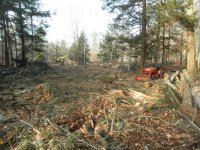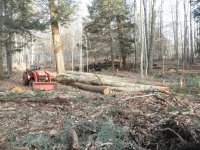Well time for an update. The surveyors were finally here to lay out the actual road bed for the access road. Had a forester walk the property with me and marked the trees that I should send to the mill. A logger has been interested in taking the logs and has stopped by with some mill price info. In conversation with him he stated that the cherry trees need to get to the mill within a few weeks or they start to rot and the bark loosens. Once that happens they are firewood. Does anyone know what the logic or reason for that is or am I being fed a line so he gets in and gets the job. What time frame is involved from the time they are cut. They should be cutting by the end of the week.
I am still considering doing some of the hauling myself. A quick walk through the property with the wife yesterday and we counted about 45 black cherry trees >12" at breast height and another 40 or so assorted maples. Don't know what that will yield as far as board feet, however, I think its worth the effort. Pictures to follow when the sawdust starts flying.
Im a bit late to the party here. I am a consulting forester by profession, so im glad to see that you had one out to take a look at your situation. I work primarily in the Lake States (especially in terms of putting trees on the ground) but do/have work(ed) nation wide. Every state/tree species/markets/situation are a bit different.
Long story short, and probably water under the bridge, is that you can think of hardwood as a piece of fruit you would buy at the market. When it's fresh, pristine, and blemish free you would look at the price tag and say heck that's worth it, and be willing to feed it to your most discerning relative. If it sits eventually it would become so rotten and blemished that you would only be willing to pay a small amount and feed it to your goat...
Hardwood logs are subject to the same kind of fungal attacks as any other living thing. The warmer/more humid it is the faster this happens. When they are fresh the mill is going to be willing to pay more because they are less likely to get a bad apple... You may have driven by a sawmill and saw a large pile of logs that have a bunch of sprinklers spraying water on them. They do this to deny the fungus heat and oxygen and delay the color altering affects it brings with it.
Spalted/fungal affected wood can be beautiful, but it wont be consistent from log to log. When you are selling truckloads at a time inconsistencies are seen as just that..oddballs.
What did the forester say about how long the cherry could sit? This time of year I dont doubt that at least the
margin on it would fall in two weeks, and in his mind not make it worth picking up.
In terms of hauling it yourself. If you do make sure you know the exact lengths and small end diameters that the mill you are taking it to requires. Nothing worse than hauling wood to a mill and having it rejected. Also you might seek the advice of the forester on the "grade" of the logs the mill is seeking/taking, and have he/she come and grade your wood prior to delivering it to the mill. Shady mills would be glad to pay you a lesser grade price for superior grade log. If you dont know the difference they wont be the ones to tell you.
Lastly, be sure that the mill has no insurance requirements(liability & comp) for those delivering wood to their business. Mom and Pop types usually don't, but they also aren't the ones who would/will pay a premium for quality timber.
Good luck!



